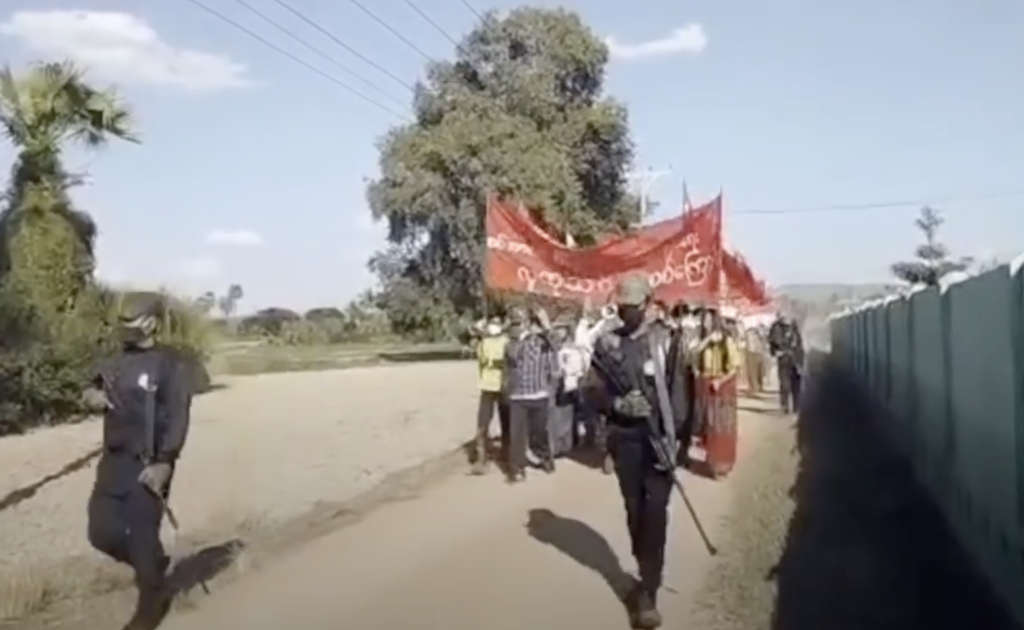On 10 February 2024, a spokesperson for Myanmar’s ruling military junta, the State Administration Council (SAC), announced that the country’s inoperative conscription law would soon be enforced. Accordingly, 14 million nationals would be eligible for conscription. This includes all men aged 18 to 35, and women aged 18 to 27. For those with specialist experience, the upper age limits are higher.
The announcement came three years after the military, under Senior General Min Aung Hlaing, seized power in a coup, nullified the results of the November 2020 elections, and detained Aung San Suu Kyi and other senior members of the then ruling National League for Democracy. With these measures, the military put an end to the country’s decade-long, so-called democratic transition.
But when the SAC proceeded to crack down on nation-wide anti-coup protests, killing and arresting thousands in the process, many activists and organisers fled urban areas to join armed opposition groups in the countryside. These groups include established organisations like the Karen National Liberation Army and the All Burma Students’ Democratic Front, as well as newly formed People’s Defence Forces (PDFs), which mostly young people set up autonomously across the country.
The anti-coup movement and migrant workers
The anti-coup opposition movement—a loose but extensive network of protesters, activists, striking workers, deposed parliamentarians, armed groups, and sympathetic supporters—has come to be known as Myanmar’s Spring Revolution. Its most progressive impulses are far more politically ambitious than the neoliberal, and often reactionary, “democratic transition” that preceded the coup.
Amid this revolutionary upsurge, armed opposition groups have inflicted heavy losses on the Myanmar military. The SAC and its organizational infrastructure have lost effective control of well over half the country’s territory. Meanwhile, desertions and defections from the military have become commonplace.
The SAC’s move to enforce conscription, which got underway in April, is widely seen as a response to these setbacks.
The announcement triggered a panicked exodus. Many young people joined armed opposition groups, rather than allow themselves to be conscripted into a military that they abhor. But most individuals seeking to evade conscription have gone abroad to join the ranks of foreign migrant workers, adding in this way to the already large number of nationals who have fled violence, persecution, and economic collapse in Myanmar since the coup.
In one case, fear that the SAC would restrict passports to prevent people from escaping abroad caused a stampede at a passport office in Mandalay, killing two passport applicants and injuring a half dozen others.
Facing this mass movement of young people out of the country, the SAC suspended issuance of foreign work permits under its bilateral Memorandum of Understanding (MoU) system at the start of May for all men eligible to be conscripted. A week later, the military walked back its restrictions, a policy reversal that analysts attribute to the SAC’s financial reliance on migrants’ remittances and tax payments.
Yet, the largest group of Myanmar migrant workers—an estimated 2.5 million—reside in neighbouring Thailand, and most entered that country without official employment visas and continue to live and work without legal documentation. In other words, undocumented border crossing remains a principal way for Myanmar nationals to evade the SAC’s attempts to control their politics, restrict their mobility, and tax their foreign incomes.

Consider taxation. The February 2024 announcement regarding conscription followed another initiative the SAC introduced the year prior, in September 2023, according to which Myanmar migrants working abroad under the MoU arrangement would be required to remit 25 percent of their earnings through a SAC-controlled financial mechanism at a fixed exchange rate well below the market rate. Soon afterwards, the SAC introduced a separate measure to tax the incomes of Myanmar nationals working abroad at a flat rate of two percent.
The SAC’s increasingly dire financial situation is a clear motivation behind both initiatives. But also, migrant workers have been key funders of PDFs and other opposition groups. Limiting migrants’ financial capacities to support these groups is another plausible motivation behind the SAC’s attempts to control and drain the incomes of Myanmar nationals working abroad.
The autonomy of migration
The cross-border movement of migrants and refugees is commonly characterized as an effect of other phenomena—of war, for example, or of economic malaise. Indeed, the very categories of “migrant” and “refugee” reduce the multifaceted character of cross-border mobility to a set of mutually exclusive cause-and-effect dynamics. Rarely is the migrant/refugee understood as a political actor in her own right.
Arguing against this mechanistic reading of mobility, migrant solidarity activists and critical researchers developed, beginning in the early 2000s, a conceptual approach known as the autonomy of migration. The aim was to centre, so as to better support, the political agency of marginalized border crossers.
The autonomy of migration approach became prominent among activists fighting right-wing violence and racist vitriol directed at refugees and undocumented migrants in Europe. For the most part, proponents focused on the tactics by which individuals from Africa and West Asia struggled to circumvent the European Union’s Schengen border controls. Bringing the autonomy of migration approach to bear on the Global South has been far less common, though Ranabir Samaddar and Sandro Mezzadra are important exceptions.
But also, by focusing on tactics used to circumvent border controls, writing on the autonomy of migration has largely neglected the explicitly revolutionary commitments informing Italian operaismo and autonomia, which provided the autonomy of migration approach with its conceptual groundwork. Consider, for example, Mario Tronti’s seminal 1962 essay Lenin in England or Antonio Negri’s 1978 lectures at the École Normale Supérieure, published in English in 1991 as Marx Beyond Marx. Proletarian mobility, Negri argues in the book, is not just implicitly revolutionary—that is, subversive and transformative in its effects; the conditions of this mobility can also fuel an explicitly revolutionary subjectivity.
In Myanmar’s post-coup moment, migrants/refugees have demonstrated—in their acts of evasion, in their repudiation of military control, and in the unity of subversive mobility and political commitment that they embody—the autonomy of migration at its most revolutionary. As self-consciously political subjects, they give the lie to the notion of an apolitical “economic” migrant.
Many of those now living and working in neighbouring countries, often without documentation, left Myanmar to escape conscription, or to evade arrest for their involvement in anti-coup protests or the post-coup general strike. Or they fled retaliatory military attacks on their hometowns after supporting anti-SAC forces.
Even among those who went abroad in search of employment before the coup, anti-military sentiment is rife, as is support for the revolution. These are positions I regularly encounter among Myanmar migrants in Thailand (where I do research) and in Singapore (where I live).
Myanmar migrants have also been a major source of financial support to PDFs and other opposition armed groups. And in cases, migrant workers have quit their jobs in neighbouring countries to take up arms in Myanmar—joining PDFs and other opposition groups fighting the SAC and its military apparatus.
In the Myanmar revolution, then, the “migrant” is a self-consciously political subject. And her recalcitrant mobility is subversive.








